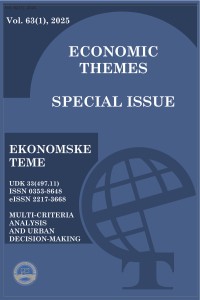Economic Themes (2025) 63 (1) 3, 45-58
Dejan Brcanov, Stojanka Dakić, Anja Dacić, Mirko Savić
Abstract: The gender gap problem reflects persistent inequalities between men and women across economic participation, education, health, and political representation, driven by social, cultural, and institutional biases that restrict equal opportunities and outcomes. This paper explores the state of gender equality in Europe by constructing composite variables for each area through principal component analysis and applying cluster analysis to classify countries into four distinct groups. The first cluster includes Nordic countries with nearly complete gender equality; the second cluster consists of developed Western European countries with high educational and health outcomes, but lower political and economic opportunities for women. The third cluster comprises former socialist bloc countries with moderate educational and health indicators, but low economic and political inclusion of women, and finally the fourth cluster includes countries with significant challenges in achieving equality due to traditional norms and weak policies. The results indicate the need for tailored policies that would enhance economic opportunities and political participation for women, depending on the specific characteristics of each group of countries.
Keywords: Gender gap; gender inequality; economic participation; labour market; principal component; cluster analysis.
GENDER EQUALITY IN EUROPE: DIFFERENCES AND CHALLENGES AMONG EUROPEAN COUNTRIES
Dejan Brcanov, Stojanka Dakić, Anja Dacić, Mirko Savić
Abstract: The gender gap problem reflects persistent inequalities between men and women across economic participation, education, health, and political representation, driven by social, cultural, and institutional biases that restrict equal opportunities and outcomes. This paper explores the state of gender equality in Europe by constructing composite variables for each area through principal component analysis and applying cluster analysis to classify countries into four distinct groups. The first cluster includes Nordic countries with nearly complete gender equality; the second cluster consists of developed Western European countries with high educational and health outcomes, but lower political and economic opportunities for women. The third cluster comprises former socialist bloc countries with moderate educational and health indicators, but low economic and political inclusion of women, and finally the fourth cluster includes countries with significant challenges in achieving equality due to traditional norms and weak policies. The results indicate the need for tailored policies that would enhance economic opportunities and political participation for women, depending on the specific characteristics of each group of countries.
Keywords: Gender gap; gender inequality; economic participation; labour market; principal component; cluster analysis.

